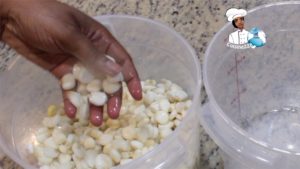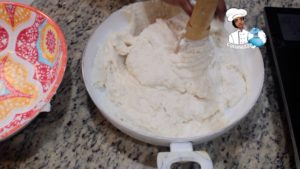
 Other names: Kom, Dokunoo, Dokono, Dokunu, Dokonou, Kenkey
Other names: Kom, Dokunoo, Dokono, Dokunu, Dokonou, Kenkey
Kenkey, dorkunu, dokonou or kom is a staple dish in Togo, Benin and Ghana similar to sourdough dumpling, usually served with pepper sauce, shitor (Yebesse fionfion) and fried fish or stew. It is usually made from ground corn (maize), like banku, Akoume, sadza and ugali. Making Kenkey involves letting the maize ferment before cooking for at least 5 days. Therefore, preparation takes a few days in order to let the dough ferment. After fermentation, the kenkey is partially cooked, wrapped in corn husks, plastic or foil, and steamed.
My one and only!!! My favorite food: Kom (Togo) Dokonou (Benin). Ghana has a similar dish Kenkey.
Our Kom is softer than Kenkey. Kom is served with a soup or stew or sauce. I prefer to eat my Kom with Yébésséssi, Ebesse fionfion, fried fish and sardine.
6 – 8 cups of corn
Agbelima (optional)
In a large container cover the corn with just enough water to dampen all of it. Set it in a warm place, such as a warmed oven or on top of the refrigerator, for 5 days. Fermentation may take longer than two days, especially in cool climates.
When it is properly fermented, it should have a slightly sour, but not unpleasant aroma, rinse and grind the corn.
Knead the fermented dough with your hands until it is thoroughly mixed and slightly stiffened. Divide the dough into two equal parts.
In a large pot, cook one part of the fermented dough. Cook for about ten minutes, stirring constantly and vigorously. Remove from heat. This half of the dough is called the “aflata”.
Combine the aflata with the remaining uncooked dough. Mix well.
Divide the aflata-dough mixture into serving-sized pieces. Wrap the pieces tightly in corn husks, or foil. At this point you can put it in the fridge or freezer until you are ready to cook
Steam the Kom for 30 to 60 mins, depending on their size and thickness. Serve room-temperature.
Grind 1 onion, 2 tomatoes and green chilies together, grind until smooth, but with a little texture remaining in the sauce. Add Salt to taste
Season and fry your fish with some garlic, ginger, salt and pepper.
Sever with Yébésséssi, fried fish, sardine and Yébéssé fionfion





















The main consumers of this dish are GHANAIANS. It is a Ghanaian dish and not a Togolese dish. You guys always want to claim our dishes as your own. This is the same thing you did with shito, banku, kelewele and even waakye.